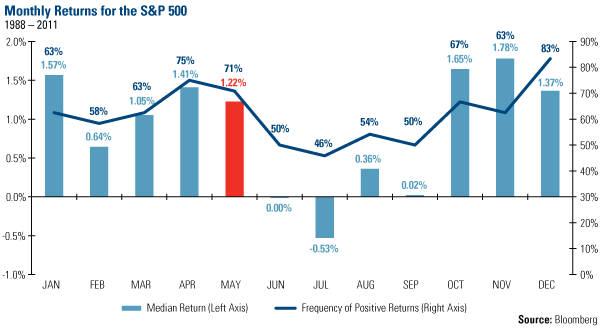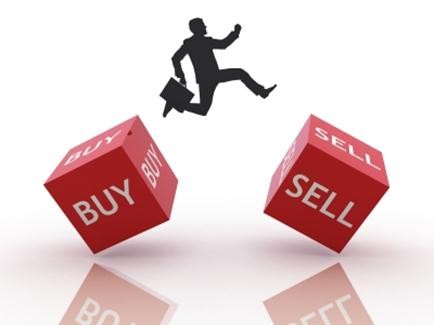Sell in May and Go Away
Post on: 22 Июль, 2015 No Comment

Reuters
You’ve probably heard the old adage: Sell in May and go away. It’s a nice little rhyme, and it does have a basis in the market’s seasonal patterns. Historically, the stock market has typically been weaker from May to October than it has from November through April. Going back to 1950, the Dow is just about flat from May to October but up over 7% on average from November to April.
We’ve certainly seen plenty of summer and fall selling over the last three years, and many investors are understandably gun shy, wondering if history will repeat itself this year. On the one hand, the market has had a fantastic run, up almost 25% since the lows of last summer, so you have to expect profit-taking at some point. But sell in May and go away? That’s taking it a bit too far, especially this year.
There are two main reasons why I say this.
Reason #1: Much of the selling the last three years was caused by the European debt crisis, and that crisis is in a much better place now that the European Central Bank announced that it would buy back government bonds of countries that run into trouble. That safety net is one piece of good news. The second is that no countries have taken advantage of this offer yet. So while Europe’s debt problems haven’t gone away, they are being better managed. Investors are less fearful about it now than in recent years, and I  don’t expect an extreme sell-off like we’ve seen in the past.
That’s not to say we won’t see some volatility, and the market has gotten choppier as earnings season cranks up. Expectations are very low, and while the current season hasn’t gotten off to a spectacular start, my feeling is that results have been not as bad as many feared, which lessens the likelihood of a steep drop.
So for this May especially, I don’t think “going away” is a good idea. 
Reason #2: In addition to downside risks not being major, there is a chance that we could see all three major central banks (the U.S. Federal Reserve, the Bank of Japan, and the European Central Bank) engage in quantitative easing at the same time (two of the three have already announced QE). Quantitative easing is arguably the single biggest factor behind the market’s run to all-time highs, and the fact that the three major central banks of the world could have it going at the same time makes things very different from the last three Mays.
3 Investments to Stay Away From
I would not be surprised at all to see the market churn more in May without a clear direction emerging. Stock picking is obviously always important, but in a directionless market, it’s even more so. With that in mind, there are a few investments I plan on staying away from in the coming weeks, and there are others I like quite a bit. Let me share some of each in one specific sector: retail.
High-End Retail. I will personally be avoiding the higher-end consumer discretionary sector. Retailers like Saks (SKS ), Tiffany (TIF ), and Abercrombie Fitch (ANF ) might create beautiful products, but they their stocks’ returns may not look so pretty. Here in the U.S. consumers are still cautious with their money, which makes it tough on high-end retailers. Yes, the economy is recovering, but we’ve seen some soft data recently, which has hurt consumer confidence. Until confidence is back up, I expect people to find ways to buy more for less, and in a moment I’ll tell you which retailers are best helping people do that.
Globally, I’m also concerned that the middle class in China and Europe are a bit extended on their credit. Companies like Tiffany and Abercrombie are especially susceptible to any downturn in spending in those locations. Consumers in these regions were doing their fair share of high-end brand shopping, but between the real estate bubble still bursting in their respective countries and a plethora of new international competitors offering cheaper prices, these companies are quite vulnerable.
3 Stocks to Buy
On the flip side, I see opportunity in select lower-ended retailers that consumers will be turning to. I’m not talking about a company like Wal-Mart (WMT ), which operates with very thin margins, but companies like Gap (GPS ), Target (TGT ), and Kohl’s (KSS ).

The Gap includes the popular stores Gap, Old Navy, and Banana Republic. This retailer has had decent growth, profitability, a respectable balance sheet, and a very reasonable valuation at about 12X earnings. The company also has a long track record as a specialty apparel retailer and I expect to see its strong growth continue in the future given its high-quality products at reasonable prices.
Target has really come a long way in terms of fashion, now partnering up with popular designers like Sonia Kashuk and Kate Young (one of the most influential celebrity stylists of the decade). Target follows through with their slogan; you do get more for less. Financially, Target is rock solid. The company pays a respectable 2% dividend, and has raised their dividend 45 consecutive years. Target also has a strong growth plan, and is expected to boost sales to $100 billion and EPS to $8.00 by 2017.
Kohl’ has made some serious improvements in its clothing line by bringing in respected, well-known designers (like Vera Wang) and has celebrities (like Jennifer Lopez) attach their names to the brand. And I’ll admit it, I’ve started shopping more at Kohl’s. As I’m writing this article, I’m wearing a beautiful skirt that I bought there.
But it’s not just their designs that caught my attention, their financials grabbed me as well. Kohl’s last reported earnings of $1.66, beating estimates by $0.03. Sales popped 5.4% to $6.3 billion, along with a 1.9% bump in comps sales. The company’s e-commerce sales accelerated 43% in the quarter and 42% in the full year to $1.4 billion. As Kohl’s continues to invest in e-commerce through technical upgrades, management expects e-commerce to continue to grow. This company has a strong growth trend and is a smart investment in the retail industry.
So while this isn’t the year to sell in May and go away, it also isn’t a year to expect a rising tide to lift all boats. In that kind of market, I will be focusing on stocks with solid and predictable earnings growth, strong catalysts and exceptional long-term opportunities.
 
GameChangerStocks.com.
+ Follow Fox Business on Facebook














